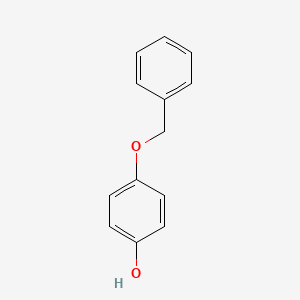D0711 | 4-(benzyloxyl)phenol
| Toxicity | Dose | Time | Species | Model | Method | Action | Positive criterion | Reference |
|---|---|---|---|---|---|---|---|---|
| MEMBRANE POTENTIAL | 18.46±1.51 | human | qHTS-HepG2 | MMP assay | decrease | IC50 | 163 | |
| MEMBRANE POTENTIAL | 7.4 | human | HepG2 | MMP assay | decrease | IC50 | 163 | |
| MEMBRANE POTENTIAL | 9.04±8.10 | rat | hepatocytes | MMP assay | decrease | IC50 | 163 | |
| Pictogram | Signal | Statements | Precautionary Statement Codes |
|---|---|---|---|
 |
Warning |
H317: May cause an allergic skin reaction [Warning Sensitization, Skin] H319: Causes serious eye irritation [Warning Serious eye damage/eye irritation] |
P261, P264, P272, P280, P302+P352, P305+P351+P338, P321, P333+P313, P337+P313, P363, and P501; (The corresponding statement to each P-code can be found at the GHS Classification page.) |
 |
Warning |
Aggregated GHS information provided by 204 companies from 3 notifications to the ECHA C&L Inventory. Each notification may be associated with multiple companies. H317 (100%): May cause an allergic skin reaction [Warning Sensitization, Skin] H319 (100%): Causes serious eye irritation [Warning Serious eye damage/eye irritation] Information may vary between notifications depending on impurities, additives, and other factors. The percentage value in parenthesis indicates the notified classification ratio from companies that provide hazard codes. Only hazard codes with percentage values above 10% are shown. |
P261, P264, P272, P280, P302+P352, P305+P351+P338, P321, P333+P313, P337+P313, P363, and P501; (The corresponding statement to each P-code can be found at the GHS Classification page.) |
 |
Warning |
H317: May cause an allergic skin reaction [Warning Sensitization, Skin] H319: Causes serious eye irritation [Warning Serious eye damage/eye irritation] |
P261, P264, P272, P280, P302+P352, P305+P351+P338, P321, P333+P313, P337+P313, P363, and P501; (The corresponding statement to each P-code can be found at the GHS Classification page.) |
| (p)-Benzyloxyphenol | 103-16-2 | 103H162 |
| 4(benzyloxy)phenol | 4-(Benzyloxy)phenol | 4-(Benzyloxy)phenol |
| 4-(Benzyloxy)phenol | 4-(Benzyloxy)phenol (Monobenzone) | 4-(Benzyloxy)phenol, 98% |
| 4-(Benzyloxy)phenol, >=99% | 4-(Benzyloxyl)phenol | 4-(Phenylmethoxy)phenol |
| 4-(benzyloxy)-phenol | 4-06-00-05728 (Beilstein Handbook Reference) | 4-Benzyloxy-phenol |
| 4-Benzyloxyphenol | 4-benzoxyphenol | 4-benzyloxy phenol |
| 4-benzyloxylphenol | 4-phenylmethoxy-phenol | 4-phenylmethoxyphenol |
| 9L2KA76MG5 | A800687 | AB00513959 |
| AB00513959-03 | AB00513959_04 | AB00513959_05 |
| AB1001901 | AC-2492 | ACMC-20984r |
| ACN-034824 | ACT04723 | AI3-14325 |
| AK-41211 | AKOS000119555 | AM20020110 |
| ANW-14809 | Agerite alba | Alba |
| Alba-Dome | BBL022939 | BCP09974 |
| BDBM50410520 | BIDD:ER0003 | BPBio1_000864 |
| BR-41211 | BRD-K54262262-001-01-7 | BRD-K54262262-001-06-6 |
| BRN 1958305 | BSPBio_000784 | Benoquin |
| Benoquin (TN) | Benzoquin | Benzyl hydroquinone |
| Benzyl p-hydroxyphenyl ether | Benzylhydroquinone | C14244 |
| CAS-103-16-2 | CB0111 | CCG-213094 |
| CHEBI:34380 | CHEMBL1388 | CS-B0870 |
| CTK3J0567 | Carmifal | D05072 |
| DB00600 | DSSTox_CID_717 | DSSTox_GSID_20717 |
| DSSTox_RID_75755 | DTXSID2020717 | Depigman |
| Dermochinona | EBD45536 | EINECS 203-083-3 |
| F0777-0782 | FT-0616695 | GTPL6830 |
| HMS1570H06 | HMS1580P12 | HMS2097H06 |
| HMS3655K15 | HMS3714H06 | HSDB 4019 |
| HY-30272 | Hydrochinon monobenzylether | Hydrochinon monobenzylether [Czech] |
| Hydroquinone benzyl ether | Hydroquinone monobenzyl ether | Hydroquinone monobenzyl ether |
| Hydroquinone monobenzyl ether | Hydroquinone monobenzyl ether | Hydroquinone monobenzylether |
| KS-0000098L | KSC490K6P | L650 |
| LS-7440 | LS10011 | Leucodinine |
| MCULE-6689165962 | MFCD00002333 | Monobenzon |
| Monobenzona | Monobenzona [INN-Spanish] | Monobenzone |
| Monobenzone | Monobenzone | Monobenzone (Benoquin) |
| Monobenzone (USP/INN) | Monobenzone [INN] | Monobenzone [USP:INN] |
| Monobenzone(Benoquin) | Monobenzone, United States Pharmacopeia (USP) Reference Standard | Monobenzone; |
| Monobenzonum | Monobenzonum [INN-Latin] | Monobenzyl Ether of Hydroquinone |
| Monobenzyl ether hydroquinone | Monobenzyl hydroquinone | NCGC00016360-01 |
| NCGC00016360-02 | NCGC00016360-03 | NCGC00016360-05 |
| NCGC00016360-06 | NCGC00258699-01 | NE10175 |
| NSC 2132 | NSC-2132 | NSC-33918 |
| NSC-758211 | NSC2132 | NSC33918 |
| NSC758211 | Oprea1_698781 | P-(BENZYLOXY)PHENOL |
| P-BENZYLOXYPHENOL | PBP | PBP |
| PBP | PBP | PS-8213 |
| Pharmakon1600-01503031 | Phenol, 4-(phenylmethoxy)- | Phenol, p-(benzyloxy)- |
| Pigmex | Prestwick0_000912 | Prestwick1_000912 |
| Prestwick2_000912 | Prestwick3_000912 | PubChem10471 |
| Q-200440 | Q2768526 | RTC-062014 |
| SBB038524 | SC-19155 | SCHEMBL35631 |
| SPBio_002973 | SR-05000001819 | SR-05000001819-1 |
| SR-05000001819-2 | SR-05000001819-3 | ST50170917 |
| STL283939 | SW197310-3 | SY001650 |
| Superlite | Superlite (antioxidant) | TC-062014 |
| TRA0001796 | Tox21_110396 | Tox21_110396_1 |
| Tox21_201147 | UNII-9L2KA76MG5 | VYQNWZOUAUKGHI-UHFFFAOYSA-N |
| WLN: QR DO1R | Z199511588 | ZINC1748 |
| p-Hydroxyphenyl benzyl ether | p-benzoxyphenol | p-benzyloxy phenol |
| p-benzyloxy-phenol | para-(Benzyloxy)phenol | s1652 |

